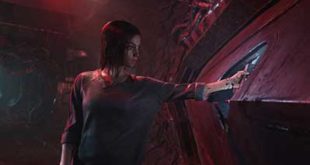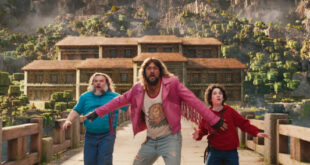AVATAR takes us to a spectacular world beyond imagination, where a newcomer from Earth embarks on an epic adventure, ultimately fighting to save the alien world he has learned to call home. James Cameron, the Oscar®-winning director of “Titanic,” first conceived of the film 15 years ago, when the means to realize his vision did not yet exist. Now, after four years of production, AVATAR, a live action film with a new generation of special effects, delivers a fully immersive cinematic experience of a new kind, where the revolutionary technology invented to make the film disappears into the emotion of the characters and the sweep of the story.
We enter the alien world through the eyes of Jake Sully, a former Marine confined to a wheelchair. But despite his broken body, Jake is still a warrior at heart. He is recruited to travel light years to the human outpost on Pandora, where a corporate consortium is mining a rare mineral that is the key to solving Earth’s energy crisis. Because Pandora’s atmosphere is toxic, they have created the Avatar Program, in which human “drivers” have their consciousness linked to an avatar, a remotely-controlled biological body that can survive in the lethal air. These avatars are genetically engineered hybrids of human DNA mixed with DNA from the natives of Pandora… the Na’vi.
Reborn in his avatar form, Jake can walk again. He is given a mission to infiltrate the Na’vi, who have become a major obstacle to mining the precious ore. But a beautiful Na’vi female, Neytiri, saves Jake’s life, and this changes everything. Jake is taken in by her clan, and learns to become one of them, which involves many tests and adventures. As Jake’s relationship with his reluctant teacher Neytiri deepens, he learns to respect the Na’vi way and finally takes his place among them. Soon he will face the ultimate test as he leads them in an epic battle that will decide the fate of an entire world.
BEGINNINGS
“AVATAR is the most challenging film I’ve ever made,” says writer-director James Cameron. And that is a declaration with resonance, given Cameron’s global renown as a master storyteller: his “Titanic,” “The Terminator,” “Terminator 2: Judgment Day,” “Aliens,” “True Lies,” and “The Abyss” were groundbreaking films featuring a mix of spectacle, compelling narratives and characters, and technical wizardry resolutely in service of story and emotion.
AVATAR’s central figure, Jake Sully (Sam Worthington) is a relatable everyman who unexpectedly rises to become a hero, as events draw him deeper into a clash of civilizations, between the Earth corporations bent on “developing” Pandora and the indigenous Na’vi. Jake is a former Marine who places honor and duty above all, but he must eventually choose between his personal honor, in defense of what is right, and his supposed duty to those who have tasked him with his mission.
“I wanted to create a familiar type of adventure in an unfamiliar environment, “ Cameron explains, “by setting the classic tale of a newcomer to a foreign land and culture on an alien planet. The story is by design classic in its broad strokes, but we have plenty of twists and turns in store for the audience. I’ve dreamed of creating a film like this, set on another world of great danger and beauty, since I was a kid reading pulp science fiction and comic books by the truckload, and sitting in math class drawing creatures and aliens behind my propped up textbook. With AVATAR, I finally got my chance.”
WHERE AND WHEN
AVATAR takes place on Pandora, a moon with an Earthlike environment that orbits a gas-giant planet called Polyphemus in the Alpha Centauri-A star system. At 4.4 light years away, Alpha Centauri is our nearest stellar neighbor, and when it is discovered that Pandora is rich in a rare-earth mineral called Unobtainium, the race is on to mine the new world’s resources. Unobtainium does not exist in our solar system, but it is the key to solving Earth’s energy crisis in the twenty second century, so the Resources Development Administration (RDA) is spending hundreds of billions of dollars to mine the distant world. Our story takes place in 2154, three decades after a mining colony was established on Pandora. The encroachment by human activities into the territory of the indigenous Na’vi has created increasing tension between the two species and has set them down a path to war.
By a twist of fate, the death of his twin brother, Jake Sully is thrust into the middle of this tense situation. He is on Pandora to be the newest “driver” for the Avatar Program, an attempt by human scientists to create a “bridge of trust” with the Na’vi by using genetically engineered avatar bodies to walk among these alien giants in a familiar form. But Jake is co-opted by Colonel Miles Quaritch, the head of security for the human colony, to infiltrate the local clan and learn how to control them or defeat them. Quaritch is the commander of Secops, the private security force that defends Hell’s Gate against the fierce predators of Pandora and the equally fierce Na’vi. They are a scruffy but well equipped mercenary army, complete with heavily armed tilt-rotor aircraft and “AMP Suits”– huge exeskeletal fighting suits.
Jake becomes the “wrong guy” to have placed in such a volatile position. When he finds himself torn between the Na’vi and the RDA forces that are bent on destroying their ancestral home of 10,000 years, Jake takes action. And all hell breaks loose.
HOW THEY DID IT
Cameron was not interested in using makeup to create his alien species. Humanoid aliens have been played by actors in makeup for decades, since the B-movies of the ’50s, and on through four decades of “Star Trek” spin offs and other science fiction films and TV shows. Virtually every design and method for putting rubber onto actors’ faces has now been explored, and in addition it is inherently limiting. The size and the spacing of the eyes can’t be changed. The proportions of the body can’t be changed, nor can the overall size of the character. And rubber appliance makeup is limiting to the actor’s performance, because it acts as a barrier between the actor and the lens.
With the performance capture method, none of these negatives apply. Though the CG characters in AVATAR resemble the actors who play them, their fundamental proportions are different. The Na’vi eyes are twice the diameter of human eyes, and they are spaced farther apart. The Na’vi are much leaner than humans, with longer necks, and they have different bone and muscle structures, including most obviously, their three- fingered hands. As CG characters, the Na’vi and the avatars can be made much larger than human. Blue make-up would have made the skin opaque, but with CG the characters can be given translucent skin which behaves like real skin, in which the pigment at the surface does not mask the red glow of the blood beneath, such as when strong sunlight hits the backs of the characters’ ears. All of these subtleties combine to allow the creation of seemingly living creatures.
Cameron was looking for a way to take alien character creation into the 21st century. In 1995 Cameron saw the rapid advances in CG characters, and thought that his dream project set on another world might be possible to make. Having already created CG milestone characters in “The Abyss” and “Terminator 2: Judgment Day,” Cameron wanted to push the CG arts to new heights, and so the visually ambitious AVATAR was written. But when the treatment was broken down by CG experts, Cameron realized that the technologies required for photorealism were still years off, so the project was shelved.
When Cameron revived the project in 2005, it seemed the techniques required were right around the corner. At that time there was still concern that the characters would not appear quite real, and would suffer from the disturbing “dead eye” effect seen in some early performance capture films. Cameron’s team sought to go far beyond prior efforts, to ensure the complete reality of the characters. To do this, they developed a new “image-based facial performance capture” system, using a head-rig camera to accurately record the smallest nuances of the actors’ facial performances. Instead of using the motion capture technique of placing reflective markers on the actors’ faces to capture their expressions, the actors wore special headgear, not unlike a football helmet, to which a tiny camera was attached. The rig faced towards the actors’ faces and the camera recorded facial expression and muscle movements to a degree never before possible. Most importantly, the camera recorded eye movement, which had not been the case with prior systems.
The head-rig system allowed actors facial performances to be captured with unprecedented clarity and precision. And since the head-rig system did not rely on the motion capture cameras of the past, those cameras were now being used only to capture body movement, so they could be moved much farther from the actors. This allowed the AVATAR team to use a much larger capture environment, or “Volume,” than had ever been used before. At six times the size of previous capture volumes, the Volume for AVATAR was used to capture live galloping horses, stunts requiring elaborate wire rigging, and even aerial dogfights between aircraft and flying creatures. So the revolutionary head-rigs were the key not only to the subtlest nuances of the characters’ emotions, but also to the film’s grandest spectacle.
Another innovation created especially for AVATAR was the Virtual Camera, which allowed Cameron to shoot scenes within his computer-generated world, just as if he were filming on a Hollywood soundstage. Through this virtual camera, the director would see not Zoë Saldana, but her 10-foot tall blue-skinned character, Neytiri. Instead of Sam Worthington and Sigourney Weaver, he would see their giant blue avatars, complete with tails and huge golden eyes. And instead of the austere gray space of the Volume, he would see the lush rainforest of Pandora, or perhaps the floating Hallelujah Mountains, or the human colony at Hell’s Gate.
After working out the details of how to exactly capture the actor’s performances, the next step was to enlist the aid of Peter Jackson’s Academy Award®-winning visual effects powerhouse WETA Digital, in New Zealand. WETA’s groundbreaking photo- real characters like Gollum in the “Lord of the Rings,” and the utterly real-seeming King Kong, led Cameron to believe that they could breathe life into his Na’vi characters.
It was critical to Cameron from the beginning that every detail of the actors’ performances be preserved in the final CG character as they appear on the screen. WETA assured him that their team of world-class animators would make it their mission to convey one hundred percent of the actors’ performances to their Na’vi or avatar characters. This involved insuring that highly accurate data be recorded at the moment the scene was performed, and it also required over a year of work by the animation team to create the “rigs” that allowed the CG characters to emote exactly like the actors whose performance they were mirroring.
IS IT ANIMATION?
Ask the animators at WETA, and they’ll tell you that the avatars and Na’vi are animated. Ask Jim Cameron, and he’ll say the characters were performed by the actors. The truth is that both are right. It took great animation skill to ensure that the characters performed exactly as the actors did. But at the same time, no liberties were taken with those performances. They were not embellished or exaggerated. The animators sought to be utterly truthful to the actors’ work, doing no more and certainly no less than what Sam, Zoë or Sigourney had done in the Volume. Of course the animators added a little bit, with the movement of the tails and ears, which the actors could not do themselves. But even here, the goal was to stay consistent with the emotions created by the actors during the original capture. So when Neytiri’s tail lashes and her ears lower in fury, they are merely further expressing the anger created by Zoë Saldana in the moment of acting the scene.
“Actors ask me if we’re trying to replace them,” says Cameron, “On the contrary, we’re trying to empower them, to give them new methods to express themselves and to create characters, without limitation. I don’t want to replace actors; I love working with actors. It’s what I do, as a director. What we’re trying to replace is the five hours in the makeup chair, which is how you used to create characters like aliens, werewolves, witches, demons and so on. Now you can be whoever or whatever you want, at any age, even change gender, and without the time and discomfort of complex makeup.”
Saldana trained for months to create a physical reality for her character, so that she could fully express Neytiri’s natural athletic grace. She knew that this was not just a voice performance for a typical animated film, but instead a “total performance,” and that every nuance of her facial expressiveness and her body movement would be captured.
Cameron and the actors worked together in the Volume for over a year, on and off. It was every bit as intense a working relationship as on a photographic film set, except that there were no lights, cameras or dolly track. It was pure acting. And this allowed everyone to really focus on performance, and the emotional truth of each moment, without all the distractions of photography. Director and actors alike were enthralled by the process, and enjoyed the rapport and focus that performance capture allowed. But it was not until Cameron and his cast saw the first finished scenes coming back from WETA that they completely realized how revolutionary this movie was going to be. Neytiri, Jake and Grace were alive.
With AVATAR it was critical to achieve an absolute authenticity of performance for all the many characters. AVATAR’s CG characters would be, says Landau, “real, soulful and emotional.” Adds Cameron: “Every nuance and bit of performance was created by the actors, who do all the things you see their CG characters do in the film, down to the slightest hand gesture. These characters ARE precisely and only what the actors created.”
AVATAR goes a step farther, by placing these photorealistic characters into a world that is also computer generated but seems completely real. Every plant, every tree, every rock is created and rendered in the computers of WETA Digital, in New Zealand. Significant breakthroughs in lighting, shading and rendering allowed WETA to create a photo-real world which was alien in its details, but which strikes the eye as completely natural. Over a Petabyte (one thousand terabytes) of digital storage was required by WETA for all the CG “assets” of the film… all the myriad plants and animals, insects, rocks, mountains and clouds. To put this in perspective, “Titanic” required 2 terabytes to create (and sink) the ship and its thousands of passengers, about 1/500th the amount used for AVATAR.
In addition to all this complexity, AVATAR was made in stereoscopic 3D. So not only did WETA need to work in 3D in creating their CG scenes (as did the other visual effects vendors such as ILM), but the live action scenes would need to be shot in 3D as well. For this Cameron used the Fusion Camera System, which he had co-developed with Vince Pace. It took seven years of development to create the Fusion system, which is the world’s most advanced stereoscopic camera system. The cameras performed flawlessly on the set of AVATAR, allowing the live action scenes to merge smoothly with the CG scenes into a unified whole.
Because of the many layers of technology developed specifically for this project, AVATAR was by far the most challenging of all of Cameron’s films to date. The filmmakers found themselves in uncharted territory, figuring out the answers as they went along. Eighteen months were spent developing the performance capture “pipeline” before a single scene was captured with the cast. “I’ve always tried to push the envelope,” Cameron points out, “But this time it pushed back. So we had to push harder. I liken the experience of making AVATAR to jumping off a cliff and knitting the parachute on the way down.”
But these revolutionary technologies are just tools in the filmmaker’s “toolbox,” and are always in the service of the story, emotion and characters. Says producer Jon Landau: “Ultimately, the audience’s reaction to AVATAR is not going to be about the technology; it’s going to be about the characters and story Jim created. The technology allows Jim to tell a story that otherwise couldn’t be told.” Adds Cameron: “It always boils down to this question: Is it a good story? Ultimately the discussion is going to be about the characters – alien and human – and their journeys.”
Landau compares Cameron’s use of these groundbreaking tools in AVATAR to the way he used then-cutting-edge advances in his Best Picture Oscar-winning “Titanic.” “On ‘Titanic’ Jim used visual effects to make people feel like a part of history; on AVATAR, he is using new technology to transport people into the future to another world.” Cameron notes, “The technology is at such a high level that it disappears, leaving only the magic… the feeling that you’re really there, and that the story, the characters, the emotions are real.”
 Premier Pop C Pop Culture News – Movies, Comics, Television, Books, Toys, Games, and More
Premier Pop C Pop Culture News – Movies, Comics, Television, Books, Toys, Games, and More 


